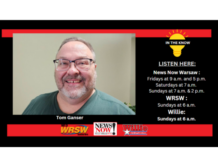

On Monday night the Warsaw School Board will vote on whether or not to put a building project referendum on the May ballot.
Last night, the school corporation held its first of two public forums on the proposed projects. The second forum is from 6:30 to 8 p.m. today in the Warsaw Community High School Performing Arts Center.
The project includes building a new Lincoln Elementary School and renovating and expanding both Washington STEM Academy and Edgewood Middle School. The cost is estimated at no more than $39.9 million, and is expected to increase the property tax rate for debt service by a maxium of 13.8 cents per $100 of assessed valuation over the 20-year life of the bonds.
Warsaw Community Schools Superintendent Dr. David Hoffert began the forum by explaining that the school district has never gone through a referendum before. The procedure became state law in 2008.
“As we look at this, this has not been a short time coming. This actually has been a very long process at this point,” Hoffert said, tracing it back to 2006-07. That year, the school corporation looked at strategic planning for its buildings and began a process to build new Madison and Leesburg elementaries and expand and renovate Jefferson and Claypool.
The plan was to then look at Lincoln and Washington in 2008-09, with phase III of the plan to take a look at the two middle schools. But the referendum procedure becoming law and the downturn in the economy pushed the facility planning back, Hoffert explained.
In 2012, the current school board had a facility study done to see if the plans from 2006-07 still met the needs of the school community. The study “made a wave” inside Warsaw because Kovert Hawkins presented a facility study estimated at about $111 million.
“That was an awful lot for our schools,” Hoffert told the audience of about 75 people. “That was an awful lot for our facilities, and that was going to be an awful lot for our taxpayers here in the Warsaw community.”
A community survey was taken last year, when then-Superintendent Dr. Craig Hintz was proposing a project in the $80 million to $90 million range. It included the three schools WCS is now considering plus the high school and updates at Harrison and Eisenhower.
“But our community came back with a really strong voice, and that voice said that $80 million was too much for our community for the time being and we really needed to go back to our facility planning and really look at not so much our wants, but our dire needs within Warsaw Community Schools,” Hoffert said.
After laying out the plans and looking at community feedback, Hoffert and the school board determined WCS’s needs – Lincoln, Washington and Edgewood.
Lincoln is priority one on the list, Hoffert said. “Lincoln Elementary has some very serious concerns. When we talk about it fiscally, it is fiscally past the point of no return,” he said.
Lincoln and Washington, and the old Madison building, all were built in 1959. Back then, districts were able to save up and buy schools, which they are not allowed to do anymore, Hoffert indicated. Districts must now fund them through bonds.
Edgewood was built in 1975 as an “open concept” school. The concept didn’t work out too well, he said, and by 1980 schools were looking at how to close those buildings up.
“As we were trying to figure out how to close them up, some things were not taken into account that we know today. In 1980 and 1985, we didn’t have to worry about things like Sandy Hook and Columbine, especially when we talk about school safety,” Hoffert said.
He then shared the needs of each school in detail, which ranged from lack of classroom space to corroded piping, leaking roofs, safety and security concerns and parking.
Chief Financial Officer Kevin Scott talked about the financial impact of the project.
If voters vote “yes” on the referendum question in May, Scott explained the tax rate impact the 13.8 cents per $100 of net assessed valuation would have on a home with an assessed valuation of $100,000.
First, a Homestead deduction of $45,000, a 35 percent Supplemental deduction and a $3,000 mortgage deduction would be subtracted, leaving the value of the home at $32,750. That’s divided by 100 and multiped by the rate of $0.138. That leaves the yearly impact of the tax rate on the $100,000 home at $45.20 per year, or $3.77 per month.
The average price of a home within the school district is $132,500, Scott said. The yearly impact of the tax rate on that would be $74.35, or $6.20 monthly.
Scott compared WCS’s 2014 tax rate to neighboring school corporations. Wawasee had the lowest at $0.58, compared to Warsaw at $0.85. The next five were Plymouth at $0.95; Kokomo, $0.97; Tippecanoe Valley, $1; Southwest Allen, $1.04; and Duneland at $1.08. The state average is $1.21, he said.
If the referendum passes and the project goes forward, Warsaw’s tax rate would increase to $0.99, placing it fourth on the list but still below other districts and the state average.
The audience was then grouped by school and their comments and questions were taken down, with answers from the board to be emailed to those who signed up.
The comments read aloud were supportive of the project. Questions included incentives for patrons of non-improved schools to pay more taxes; why aging Washington couldn’t just be knocked down, and the difference in cost; how much debt WCS owes from past projects; whether there will be redistricting; and the time frame for the referendum and alternatives if it fails.
After the forum, Cathy Snyder, Lincoln principal since 2002, said if the building project was approved, “It would mean a better environment for the students and the staff. And maybe equal opportunities for students at Lincoln and Washington and Edgewood as compared to the new buildings, what they have available.”
Snyder said the school is constantly “adjusting to the circumstances, whether it be a leak in a roof or technology issues like the electricity. We just adjust as we need to.”
She said she hasn’t heard from any parents who are against the project.
JoElla Smyth, Edgewood principal, said if voters approve the referendum, “We have increased safety, real walls. We can teach in classrooms and really teach, and not be worried that the next-door neighbor can hear everything that’s going on and it’s disruptive. Quality learning environment. If we had science labs that don’t set off (fire alarms). We wouldn’t have gas leaks. Every lab experiment – you don’t have to worry it’s going to shut everything down. We can do what we really want to do in those science labs. … The biggest thing is that it’ll increase our security.”
She said Edgewood is a good school, it just needs a lot of work.
Washington Principal Tom Ray said approval would mean, “Students at Washington are going to get a great education regardless. However, the building project will provide a safer and more conducive learning environment for the students and staff.”




